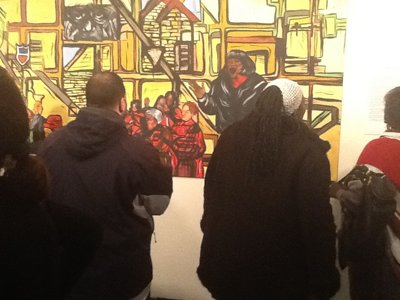For anyone who lived on the North Side during that special time, the name “Bronzevillle” is spoken with reference.
It’s the name of the legendary Milwaukee African-American community in the mid-20th Century that is remembered fondly in stark contrast to the current state of some black neighborhoods. Bronzeville was a small mecca of thriving black businesses congregated around Walnut Street that included nightclubs, restaurants, barbershops and theater devoted to serving the black community.
It’s said to be a place where visiting jazz greats like Duke Ellington and Dizzy Gillespie roamed along with local artists, musicians and other professionals who gave the area a distinct image.
Many Milwaukeeans have heard about Bronzeville even if they didn’t get to experience it. A federal highway plan project and the subsequent building of a section of the freeway causing the elimination of approximately 8,000 homes and signaled the demise of the city’s most colorful area.
Bronzeville has been gone for decades but a generation of Milwaukee students is still learning about the way it used to be and has paid tribute with an exciting display of artistic talent designed to keep the memory alive.
The exhibit, called “Standing On Their Shoulders: Memories of Bronzeville” is a student project at Milwaukee High School of the Arts, 2300 W. Highland Ave., was presented by Know Thyself, an MPS program with a grant from the Greater Milwaukee Foundation.
New York photographer Paul Calhoun helped coordinate the student project with help from local artist Brad Anthony Bernard. Both men worked with a team of MHA students to conduct oral interviews with former Bronzeville residents who told them first hand about the special place. Students then produced a series of murals in tributte that were displayed at a reception Thursday.
Bernard said both he and the students were affected by the tribute.
“It was beautiful to see how the kids reacted to meeting the elders and learned about the history,” said Bernard, who paints murals. He moved to Milwaukee in 1988 but has friends who grew up in town who often talked about Bronzeville in glowing terms.
Most of the students weren’t even born when Bronzeville was at its peak but learned an appreciation for a place that still had relevance for their parents and grandparents.
“I was surprised I hadn’t learned about it in school,” said Kwame, 16. “It was like, in other cities, you learn about the past but we didn’t.”
The experience was similar for other students on the project. Anika, 17, and Lania, 18, were also student artists for the exhibit who felt both grateful and amazed that such a place had existed with so many exciting places for residents to enjoy.
“These days, Milwaukee is kind of dead,” said Lania.
Rose Balistreri, an art teacher involved with the Bronzeville project, said it was an informative and educational project for students that would serve to remind them of a part of the black community’s past glory.
The project was just as educational for Balistreri, a Milwaukee native who said she also discovered the significance of Bronzeville for the first time.
“I have never heard about Bronzeville before (the student project).”
After their trip back in time, the MHSA students will probably keep wondering why there’s no Bronzeville in black Milwaukee today. A slow-moving city development plan to restore parts of Bronzeville entertainment district has been in effect for a number of years with little to show so far.
Until it’s finally completed, Bronzeville will remain largely a dream and a name that is spoken with reverence.
The Bronzeville exhibit will be open during school days through March 22. For available visiting hours, contact Milwaukee High School of the Arts at (414) 934-7000.


 i evaluate to yes even if there's no image
i evaluate to yes even if there's no image  i evaluate to yes even if there's no image
i evaluate to yes even if there's no image  i evaluate to yes even if there's no image
i evaluate to yes even if there's no image  i evaluate to yes even if there's no image
i evaluate to yes even if there's no image  i evaluate to yes even if there's no image
i evaluate to yes even if there's no image  i evaluate to yes even if there's no image
i evaluate to yes even if there's no image 